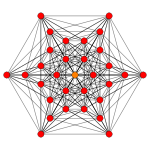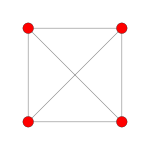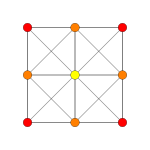Loading AI tools
Uniform 6-polytope From Wikipedia, the free encyclopedia
In geometry, a 6-demicube or demihexeract is a uniform 6-polytope, constructed from a 6-cube (hexeract) with alternated vertices removed. It is part of a dimensionally infinite family of uniform polytopes called demihypercubes.
| Demihexeract (6-demicube) | ||
|---|---|---|
 Petrie polygon projection | ||
| Type | Uniform 6-polytope | |
| Family | demihypercube | |
| Schläfli symbol | {3,33,1} = h{4,34} s{21,1,1,1,1} | |
| Coxeter diagrams |
| |
| Coxeter symbol | 131 | |
| 5-faces | 44 | 12 {31,2,1} 32 {34} |
| 4-faces | 252 | 60 {31,1,1} 192 {33} |
| Cells | 640 | 160 {31,0,1} 480 {3,3} |
| Faces | 640 | {3} |
| Edges | 240 | |
| Vertices | 32 | |
| Vertex figure | Rectified 5-simplex | |
| Symmetry group | D6, [33,1,1] = [1+,4,34] [25]+ | |
| Petrie polygon | decagon | |
| Properties | convex | |
E. L. Elte identified it in 1912 as a semiregular polytope, labeling it as HM6 for a 6-dimensional half measure polytope.
Coxeter named this polytope as 131 from its Coxeter diagram, with a ring on one of the 1-length branches, ![]()
![]()
![]()
![]()
![]()
![]()
![]()
![]()
![]() . It can named similarly by a 3-dimensional exponential Schläfli symbol or {3,33,1}.
. It can named similarly by a 3-dimensional exponential Schläfli symbol or {3,33,1}.
Cartesian coordinates for the vertices of a demihexeract centered at the origin are alternate halves of the hexeract:
with an odd number of plus signs.
This configuration matrix represents the 6-demicube. The rows and columns correspond to vertices, edges, faces, cells, 4-faces and 5-faces. The diagonal numbers say how many of each element occur in the whole 6-demicube. The nondiagonal numbers say how many of the column's element occur in or at the row's element.[1][2]
The diagonal f-vector numbers are derived through the Wythoff construction, dividing the full group order of a subgroup order by removing one mirror at a time.[3]
| D6 | k-face | fk | f0 | f1 | f2 | f3 | f4 | f5 | k-figure | notes | ||||
|---|---|---|---|---|---|---|---|---|---|---|---|---|---|---|
| A4 | ( ) | f0 | 32 | 15 | 60 | 20 | 60 | 15 | 30 | 6 | 6 | r{3,3,3,3} | D6/A4 = 32*6!/5! = 32 | |
| A3A1A1 | { } | f1 | 2 | 240 | 8 | 4 | 12 | 6 | 8 | 4 | 2 | {}x{3,3} | D6/A3A1A1 = 32*6!/4!/2/2 = 240 | |
| A3A2 | {3} | f2 | 3 | 3 | 640 | 1 | 3 | 3 | 3 | 3 | 1 | {3}v( ) | D6/A3A2 = 32*6!/4!/3! = 640 | |
| A3A1 | h{4,3} | f3 | 4 | 6 | 4 | 160 | * | 3 | 0 | 3 | 0 | {3} | D6/A3A1 = 32*6!/4!/2 = 160 | |
| A3A2 | {3,3} | 4 | 6 | 4 | * | 480 | 1 | 2 | 2 | 1 | {}v( ) | D6/A3A2 = 32*6!/4!/3! = 480 | ||
| D4A1 | h{4,3,3} | f4 | 8 | 24 | 32 | 8 | 8 | 60 | * | 2 | 0 | { } | D6/D4A1 = 32*6!/8/4!/2 = 60 | |
| A4 | {3,3,3} | 5 | 10 | 10 | 0 | 5 | * | 192 | 1 | 1 | D6/A4 = 32*6!/5! = 192 | |||
| D5 | h{4,3,3,3} | f5 | 16 | 80 | 160 | 40 | 80 | 10 | 16 | 12 | * | ( ) | D6/D5 = 32*6!/16/5! = 12 | |
| A5 | {3,3,3,3} | 6 | 15 | 20 | 0 | 15 | 0 | 6 | * | 32 | D6/A5 = 32*6!/6! = 32 | |||
| Coxeter plane | B6 | |
|---|---|---|
| Graph |  | |
| Dihedral symmetry | [12/2] | |
| Coxeter plane | D6 | D5 |
| Graph |  |
 |
| Dihedral symmetry | [10] | [8] |
| Coxeter plane | D4 | D3 |
| Graph |  |
 |
| Dihedral symmetry | [6] | [4] |
| Coxeter plane | A5 | A3 |
| Graph |  |
 |
| Dihedral symmetry | [6] | [4] |
There are 47 uniform polytopes with D6 symmetry, 31 are shared by the B6 symmetry, and 16 are unique:
The 6-demicube, 131 is third in a dimensional series of uniform polytopes, expressed by Coxeter as k31 series. The fifth figure is a Euclidean honeycomb, 331, and the final is a noncompact hyperbolic honeycomb, 431. Each progressive uniform polytope is constructed from the previous as its vertex figure.
It is also the second in a dimensional series of uniform polytopes and honeycombs, expressed by Coxeter as 13k series. The fourth figure is the Euclidean honeycomb 133 and the final is a noncompact hyperbolic honeycomb, 134.
Coxeter identified a subset of 12 vertices that form a regular skew icosahedron {3, 5} with the same symmetries as the icosahedron itself, but at different angles. He dubbed this the regular skew icosahedron.[4][5]
Seamless Wikipedia browsing. On steroids.
Every time you click a link to Wikipedia, Wiktionary or Wikiquote in your browser's search results, it will show the modern Wikiwand interface.
Wikiwand extension is a five stars, simple, with minimum permission required to keep your browsing private, safe and transparent.